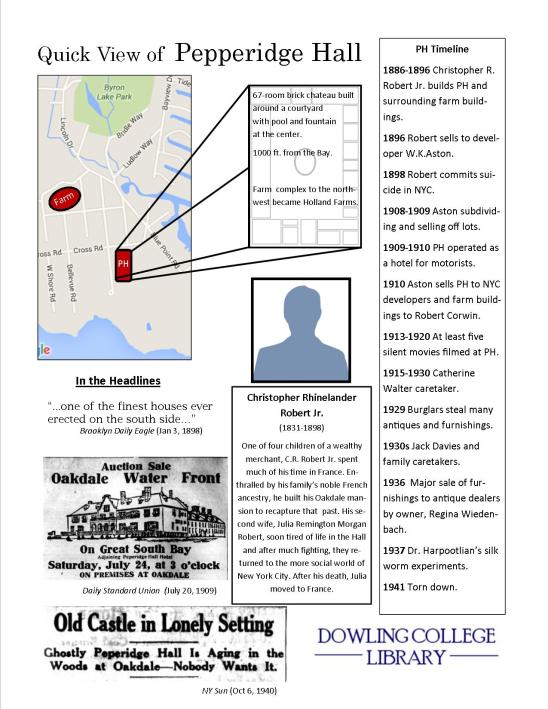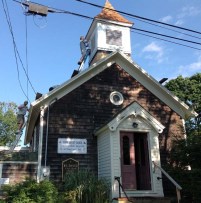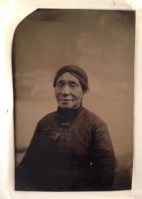Category: Preservation
Old Mansions Never Die
George Davies’ younger days would be the envy of any boy. During the Great Depression in Oakdale, he and his brothers had the run of Pepperidge Hall, a giant 19th-century mansion in walking distance of a swimming hole and the Great South Bay. Plus they had a pet duck.

George with his father Jack Davies in the courtyard of Pepperidge Hall. Photo courtesy of the Dowling College Archives & Special Collections.
On this episode you’ll hear excerpts of a talk George gave on Sept. 15, 2015 sponsored by the Dowling College Library and the Oakdale Historical Society. He describes life in the 1930s, adventures in the mansion, and nearby neighbors like Arthur K. Bourne and Louise Ockers. We’ll also find out if Dutch Schultz was hiding nearby.

Many thanks to George for sharing these invaluable memories. Most of us think of the glory days of these mansions as the Gilded Age but many of them lived on through various incarnations. George gives us a glimpse into one of those periods when the glory had passed but there was still fun to be had and living to do.
Stream in the player above or download audio.
Further Research
- The Story of Pepperidge Hall (Dowling Library Omnibus #36)
- Pepperidge Hall Estate (LI South Shore History wiki)
- Holland Farm (Dowling Library Omnibus #42)
- Oakdale Historical Society
5 Surprising Ways Historic Preservation Can Save Long Island
What better way to celebrate National Preservation Month than by interviewing Jason Crowley, Preservation Director of the Society for the Preservation of Long Island Antiquties (SPLIA)?
Jason comes to Long Island by way of Vermont, Charleston, Columbia University and years of work on the front lines of preservation. You’ll hear his take on the unique challenges and opportunities the Island represents, with our complicated map of towns, villages and hamlets accompanied by preservation laws of varying degrees of strength and effectiveness. We’ll also go over many of the local, state and national preservation agencies that you’ll want to tap when it comes time to fight for a historic site.
Founded during the post-World War II building boom on Long Island, SPLIA works to preserve all aspects of Long Island’s built environment in conjunction with partners from the East River to Montauk. Headquartered in Cold Spring Harbor, they own additional historic sites in Lloyd Harbor, East Setauket and Sag Harbor.
Finally, Jason and Connie compare notes on strategies to preserve historic landmarks, particularly religious buildings and the surviving works of noted Sayville architect Isaac H. Green.
And keep an eye out for SPLIA’s #MyLongIslandLandmarks exhibit opening in June.
Stream in the player above or download audio.
Further Research
Long Island
- Society for the Preservation of Long Island Antiquties
- Suffolk County Historic Services
- Friends of Connetquot River State Park Preserve
- Sag Harbor Historical Society
- Save Sag Harbor
- Long Island Modernism: 1930-1980 by Caroline Rob Zaleski (find in a library via WorldCat)
- A. Conger Goodyear House
- Association of Suffolk County Historical Societies (ASCHS)
- Long Island’s Chambers of Commerce
- “The Migration of Jupiter Hammon and His Family” (from the Long Island History Journal)
City
- New York City Historic Districts Council
- New York Landmarks Conservancy
- “New York City’s Landmarks Law at 50” (from the NY Times)
State
- New York State Historic Preservation Office
- Plan for Jones Beach State Park
- Preservation League of New York State
- New York Cultural Heritage Tourism Network
- Tax Credit Programs – Historic Preservation Office
- Sacred Sites (New York Landmarks Conservancy)
- Friends of the Winooski
National
Stories of Storm and Sea
Folklorists would make good podcasters. They are used to finding interesting people and getting them to tell good stories. Take Nancy Solomon for example. As the executive director of Long Island Traditions, she has spent years collecting and studying the stories of baymen, offshore fishermen, boat builders and the like. Today we’ll talk to her about a number of those stories revolving around the subject of weather lore.

The many faces of the Great South Bay from the end of West Ave in West Sayville. Photos courtesy of Chris Kretz.
We discuss how generations of fishermen have scanned the skies and shores for signs of encroaching weather. You’ll hear of hurricanes opening (and closing) inlets along Fire Island, shark sightings, narrow escapes and the lasting impact of Superstorm Sandy.
Built up over years and passed down through generations, the weather lore of Long Island fishermen can tell us much about how things have changed and how to best work with nature.
And thanks to Debra Anwar Riad for adding her voice to our intro!
Stream in the player above or download audio.
Further Research
“My Kind of Conservationist”

Murray, Susan and Cathy Barbash (l-r). Photo courtesy of the Barbash Family.
It’s 1962 and a Nor’easter has just torn through Long Island. In its wake is another storm, Long Island Parks Commissioner Robert Moses with his plan to build a road down the middle of Fire Island. It will stabilize the beach, he says. It will provide beauty and ease to the motorist, he says.
But local builder Murray Barbash notices that the road will run right through his new development of Dunewood, flattening it and pretty much anything else in its path (including Sunken Forest). Murray gets together with his brother-in-law Irving Like and the rest, if you don’t know already, is history.
Murray’s daughters Cathy and Susan knew the story but over the course of the last year they set about documenting that history. Sifting through a number of local and regional archives (including Dowling’s) they pieced together the saga of the road-that-never-was. On this episode you’ll hear from Cathy and Susan and their mother Lillian about how an unlikely coalition of Long Island “vigilantes” outwitted and outlasted the great Robert Moses.
You can soon see Cathy’s and Susan’s research for yourself when the exhibit they created is permanently installed with Seatuck at the Suffolk County Environmental Center in Islip. For now, use the handy scorecard below to keep track of who’s who in this gripping story of intrigue and power set against the natural beauty of Fire Island.
Many thanks to the Barbash family for sharing their time, memories and photos.
Stream in the player above or download audio.
Scorecard for this Episode
The Long Island “Vigilantes”
- Murray Barbash: builder with an eye for beauty, developer of Dunewood
- Lillian Barbash: his wife
- Irving Like: indomitable lawyer and Murray’s brother-in-law
- Paul Townsend: “The Wizard,” publisher of the Long Island Business News
- Robert Cushman Murphy: the tallest ornithologist in the world
The State
- Robert Moses: New York’s [insert your own adjective] Master Builder
- Nelson Rockefeller: the not-to-be-bullied Governor of New York
- Laurance Rockefeller: Nelson’s brother and noted conservationist
Long Island’s Legislators
- Stuyvesant Wainwright: Congressman from New York’s 1st District, proposed a Fire Island National Seashore when no one was looking
- Otis Pike: wins Wainwright’s seat with Moses’ backing, becomes reluctant sponsor of the Fire Island National Seashore bill
The Feds
- Stewart Udall – Secretary of the Interior, consummate insider and good guy
- President John F. Kennedy: wanted National Parks in the East, dammit
The Media
- Charles Collingwood: Saltaire resident and CBS newsman
- Wolcott Gibbs: writer for the New Yorker and Fire Island playwright
- Teddy White: Fair Harbor resident and chronicler of presidents
- Julius Monk: New York cabaret impresario whom we have to thank for the classic “Slow Down Moses”
Further Research
- Season in the Sun by Wolcott Gibbs (from the Playbill Vault)
- A Marvelous Order: An Opera About Robert Moses and Jane Jacobs
- Robert Moses: Master Builder of New York City (find in a library via WorldCat)
- “The Fire on New York’s Famous Island” (Sports Illustrated)
- Robert Moses Papers at the New York Public Library
- Rockefeller Archive Center
- Stewart Udall Oral History at the JFK Library
- Paul Townsend Collection at Dowling College
- Robert Cushman Murphy Collection at Stony Brook University
- The Films of Ron Howard (just in case)
Battling Robert Moses
 Karl Grossman has been an investigative reporter on Long Island since the early 1960s. Barely in his twenties, he cut his journalistic teeth at the Babylon Town Leader taking on one of the most powerful men in New York State: Robert Moses.
Karl Grossman has been an investigative reporter on Long Island since the early 1960s. Barely in his twenties, he cut his journalistic teeth at the Babylon Town Leader taking on one of the most powerful men in New York State: Robert Moses.
Karl covered the developing story of Moses’ plan to build a highway down the middle of Fire Island. Although the plan horrified local residents, many on the Island and in the press supported it. Through the work of Karl and papers like the Suffolk County News and the Long Island Business News and most importantly people like Murray Barbash, Irving Like and Robert Cuhsman Murphy, the plan was washed away. In its place we have the Fire Island National Seashore.
Today is part 1 of our interview with Karl on his early career, the power of the press, and how he was almost an alum of Dowling College (then known as Adelphi Suffolk College). You’ll hear about his further battles in part 2 but first in two weeks we’ll revisit the Moses fight from the perspective of the Barbash family. Stay tuned!
Stream in the player above or download audio.
Further Research
A Neighborhood of History

St. David AME Zion Church in Eastville. Photo courtesy of the Eastville Community Historical Society.
Eastville endures. Through the rise and fall of the whaling industry, over the long slow death of slavery, past the rising tide of development on the East End of Long Island. From the early 19th-century this small collection of streets and houses east of Sag Harbor, anchored around the St. David AME Zion Church, has retained its character as a place that a vibrant mix of African Americans, Native Americans, and European immigrants called home.
On this episode of the Project, we speak with Dr. Georgette Grier-Key, Executive Director and Curator of the Eastville Community Historical Society. She relates the history of the area, from the early 1830s into the late 20th century when the Society was founded.

Portrait of an Eastville resident. Photo courtesy of the Eastville Community Historical Society.
You’ll hear about the prominence of Native Americans and African Americans in the whaling industry as well as the importance of Sag Harbor as the first port of entry in New York. Among the people we discuss are Nathan Cuffee, a Montaukett member of the community who co-wrote the novel Lords of the Soil in 1905, depicting life on the east end of Long Island. Georgette also tells the surprising story of Pyrrhus Concer from nearby Southampton, an African American who, on a whaling voyage in 1845, became one of the first Americans to visit Japan.
We also discuss the challenges of documenting and preserving the histories of marginalized people. How do you prove, for example, that one of the trapdoors in the Church was used to hide escaping slaves on the Underground Railroad? How do you protect an unassuming house that is actually made out of wood from recovered 19th century shipwrecks and may contain generations of important stories?

Courtesy of the Eastville Historical Society
Sometimes you get lucky and discover a trove of tintype portraits nailed face-down into the floor of a cottage. Sometimes you fail, and structures get razed despite what they might be able to tell us about the past. Sometimes the results are mixed. Pyrrhus Concer’s house was demolished but only after significant parts had been salvaged.
You’ll hear Georgette talk about these cases and related issues along with the importance of understanding and enforcing the codes that should be helping inform decisions around such properties. You’ll also hear about ongoing projects to document African American burial sites throughout Long Island.
And if you enjoy these episodes, make sure to follow this site via email or subscribe to the podcast in iTunes. Leave us a comment and let us know what aspects of Long Island history you’d like to hear discussed.
Stream in the player above or download audio.
Further Research
- Eastville Community Historical Society
- Sag Harbor Whaling Museum
- Sylvester Manor
- Lords of the Soil by Nathan Cuffee (via Google Books)
- Eastville Tintypes from Floor to Wall (East Hampton Star)
- Burial Database Project of Enslaved African Americans
- Slavery and Salvation: Long Island’s Underground Railroad (Long Island Press)
- Slavery in New York (New York Historical Society)
Peter Fox Cohalan Part II
Suffolk County Historian Peter Fox Cohalan is back in session for part two of our interview. This week we get deeper into the history of Islip, traveling all the way from the bottom of the Bay (and who really owned it) back to Islip, England and the ancestral home of the Nicoll family.
We also get Peter Fox’s insight into historic preservation at the local and regional levels as well as the unique situations that can arise on Long Island.
Finally, we’ll hear about the work of the Robert D.L. Gardiner Foundation. As a board member, Peter Fox is involved in helping the Foundation support the study and preservation of New York history with a focus on Islip and Suffolk County.
Stream in the player above or download audio.
Further Research
Holding Court with Peter Fox Cohalan
Peter Fox Cohalan was named Suffolk County Historian in 2012 but in many ways he’s been preparing for the role his whole life. In fact, the Cohalans and history go way back. The first Cohalan in America arrived with Lafayette during the Revolution. One branch of the family led to a Grand Sachem of Tammany Hall, another to the first Catholic priest on Long Island. In his own storied career, Peter Fox has been Islip Town Supervisor, Suffolk County Executive, and State Supreme Court Judge (one of five Cohalans -including his father- to reach that position.)
With the historian’s eye for detail and the Irishman’s gift for storytelling, Peter Fox can discuss the Sayville of his youth as easily as the quarrels of the early Federalists. On this episode of the Project he recounts the Sayville of the 1930s and ’40s along with his father’s time as coach at the La Salle Military Academy in Oakdale. We’ll also hear about preservation efforts he spearheaded (like the Islip Grange in Sayville) as well as his family’s connections to the unforgettable Robert David Lion Gardiner.
Join us next week for Part 2.
Stream in the player above or download audio.
Further Research
Lightning Strikes: Saving the Wardenclyffe Lab in Shoreham
The historic site you want to preserve is up for sale for $1.3 million dollars. The good news: New York State will give you $850,000. The bad news: you have to raise the same amount. And there are other interested buyers. And the clock is ticking.
That’s the position The Tesla Science Center at Wardenclyffe (TSCW) found themselves in by the summer of 2012. But don’t worry, there’s a happy ending. In this second of a two-part interview, Jane Alcorn (TSCW president) explains how they turned things around. The secret ingredient: enlist the aide of Matthew Inman, creator of the website The Oatmeal.
In the whirlwind of events that followed, offers of help poured in and TSCW was able to meet all their goals. And then the hard work began. Jane recounts it all and lays out future plans for the site and for Nikola Tesla’s legacy of scientific innovation. Remember to check the TSCW website for ways that you can get involved.
And stay tuned as our Tesla month continues. Next week on the podcast we interview filmmaker Joe Sikorski on his Tesla/Wardenclyffe documentary Tower to the People.
Stream in the player above or download audio.
Further Research:
- The Oatmeal
- Why Tesla Was the Greatest Geek Who Ever Lived
- Jane Alcorn Interview Part 1
- Wading River Branch of the LIRR (via Art Huneke’s LIRR History site)
- Rails-to-Trails Conservancy
Hooked on Tesla
Jane Alcorn was hooked on science from an early age but it was not until a friend clued her in to the Wizard of Electricity that she became hooked on Nikola Tesla. A major scientific player at the turn of the last century, Tesla established a lab at Wardenclyffe in Shoreham, Long Island to pursue his innovative experiments in electricity, radio, and broadcast energy.
Drawing inspiration from his story, Jane and a dedicated group founded The Tesla Science Center at Wardenclyffe. And eventually, they realized the dream of securing Tesla’s lab and have begun to restore it.
In the first of a two-part interview, Jane describes that journey and provides background on what made Tesla so inspiring. You’ll hear stories of his inventions and his interactions with the people of Shoreham as well as his connections to people like Mark Twain, Stanford White and George Westinghouse.
Look for part 2 next week when we discuss the long and surprising road to purchasing the Wardenclyffe site.
Stream in the player above or download audio.
Further Research:
- Tesla Science Center at Wardenclyffe
- Nikola Tesla Museum, Belgrade
- Books on Tesla (via WorldCat)
- Tesla: Master of Lightning (PBS)
- The Electric Rise and Fall of Nikola Tesla (Marco Tempest Ted Talk)























